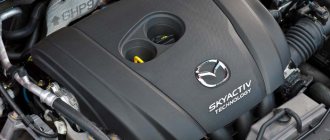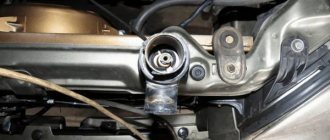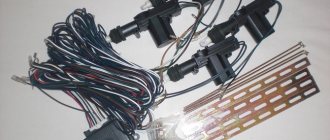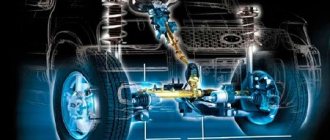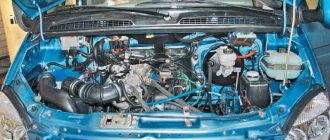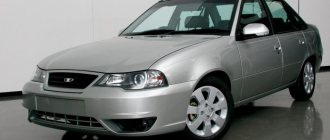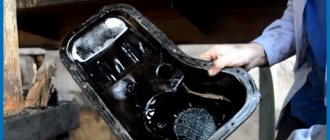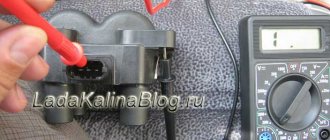During its production life, the second generation Megane delighted its customers with its bright design, high comfort and safety. The car, even by modern standards, does not look outdated, making it a rather attractive purchase.
What can we say about the reliability of the model?
After all, there are a lot of rumors about French cars, which are associated with their low reliability and maintainability. However, in the case of this model, things are actually far from so bad. So, about everything in more detail and in order.
If you are already the owner of a Renault Megane 2, we offer you to download a manual for self-repair of a Megan 2 for free, and if you are just going to get a French car, then after reading this article you will learn the nuances and features that you should pay attention to when buying a used Renault Megane 2.
Unusual galvanized design
The new redesigned design created by Patrick le Quemana looks unusual and apparently even the manufacturer really liked it. The fact is that only the external panels are galvanized; all other elements are protected only by paint. Apparently, the goal was to maintain an attractive appearance for as long as possible.
The non-galvanized metal underneath and inside showed poor performance; as soon as you neglect to take care of the drainage and drain necks, the body next to it begins to actively rust. Two drainages remove debris through Megan's wheel arches; if the leaves become clogged, water will begin to accumulate. Dirt likes to get into the rear arch, which again leads to corrosion.
Water also accumulates under the trunk floor in special niches. It would seem that there is nothing wrong, but these plastic niches are attached to the spar, which, due to humidity, begins to lose its sealant and corrode.
In addition to corrosion, there are a lot of other minor problems:
- door handles jam;
- poor sealing of optics;
- melting headlight connectors;
- rotting antenna;
- quickly weakening front door seals.
Unfortunately, owners treat little things as trifles, forgetting to do anything. Over time, little things accumulate and destroy the body even more, turning it into something “dead.” Some cars are too expensive to restore due to negligence in caring for the body.
content .. 72 73 74 75 ..Renault Megane 2. Engine knocks when cold
Causes
The sudden appearance of extraneous sounds from under the hood can frighten any driver. Such changes in the operation of the engine do not bode well - this means that you will face financial expenses. But what causes the knocking noise when the engine warms up? There are many reasons why an engine may begin to make various sounds that are not typical for normal operation. In any case, if such changes appear, it is necessary to go to a car service center as soon as possible to diagnose and identify the problem. An experienced engine mechanic, like a professional musician, hears and feels all shades of engine sounds and can easily determine the cause.
Engine wear
The culprit for the appearance of knocking noises on a cold engine may be wear. During operation, everything inside the engine gradually wears out, thermal gaps increase, which leads to knocking on a cold engine. Therefore, the appearance of extraneous noise may indicate the need to adjust valves or change hydraulic compensators. The knocking noise can also be caused by worn main bearings.
On chain engines, the appearance of knocking noises may indicate an imminent need to replace the timing belt. As a rule, they change not only the chain itself, but also the tensioner, and, if necessary, the gears. The most serious causes of engine knocking include piston knocking. Worn pistons touch the cylinder walls with their “skirt,” leaving marks on them.
Poor quality gasoline
Detonation is one of the possible causes of knocking in the engine. But unlike other reasons, knocking noise during detonation does not disappear after the engine warms up. This happens due to improper ignition of the fuel-air mixture, which leads to micro-explosions inside the combustion chamber. Prolonged driving with detonations is guaranteed to lead to engine failure. One of the most common causes of detonation is refueling with low-quality fuel. For example, if on many modern engines you fill in 92 instead of 95, this can lead to detonation.
Other
Broken parts of attachments, such as a generator, starter, water pump, power steering pump, air conditioning compressor, and drive belt tension rollers, can also be scary, emitting various sounds from the engine compartment. Worn engine and gearbox mounts can also make knocking noises when driving.
The hydraulic compensator knocks when cold. Knock of hydraulic compensators on a cold engine
Every car enthusiast, when operating a vehicle, certainly listens to how his car works. The appearance of extraneous noise during engine operation, as a rule, does not bring joy to the owner. The slightest malfunction requires urgent diagnosis and elimination of the problem. During operation, the engine generates heat, and when it is exposed to metal, the latter begins to expand. As a result, large gaps form on some parts, which lead to the appearance of extraneous noise. One of the problems can be knocking hydraulic compensators, which independently adjust the required clearance. In this article we will come to a broad explanation of the topic. What are hydraulic compensators (their design, purpose), why do they knock at different engine operating modes - read about all this below.
This element is a piston, with the help of which the thermal clearances are automatically adjusted. The operating principle of this device is quite simple. The bottom of the piston interacts with the camshaft cam. The hydraulic compensator knocks when cold. A ball valve is installed in the piston, with the help of which the damper opens and oil flow begins. As the piston is filled with oil, pressure will be applied to the existing plunger, causing the piston to move all the way to the cam. As a result, the most optimal gap is automatically installed. When the cam acts on the piston, some of the oil escapes through the valve. The piston drops slightly, thereby creating a gap. The latter on the hydraulic compressor is regulated by the flow of incoming oil. At this stage, we learned what hydraulic compensators (their devices) are.
It's easy enough to hear. The knocking of hydraulic compensators on a cold or hot engine begins to appear directly during engine operation and has a direct impact on the stability of its operation.
The reasons that the element is knocking “hot” are as follows:
-The oil pump has failed. The system does not create the required pressure. -The hydraulics of the hydraulic compensator are broken, that is, the system does not have the required amount of oil or, conversely, there is an excess of it. -The landing site of the part has increased significantly due to the heating of the engine, during which the metals expand.
These causes of malfunction are typical only for a warm engine. It is worth noting that the sound of these elements on a hot engine is quite rare. Most often, the hydraulic compensator knocks “when cold”, and for both modes the sound may appear due to low quality oil. It also occurs due to a contaminated lubricant purification system.
Knock of hydraulic compensators on a cold engine
There are many more reasons why a part knocks on a cold engine than on a hot one. It is not always possible to determine the source of the “clatter” of hydraulic compensators. Therefore, in some situations it is advisable to seek help from a specialized station.
The main reasons why hydraulic compensators knock on a cold engine:
-Production on the plunger. -Heavily contaminated engine oil due to violation of shift timing. Note: when the engine warms up for this reason, the knocking will disappear, since a new batch of oil supplied to the part will wash out the exhaust. -Formation of bubbles, which negatively affects the compressibility of the lubricant. - Failure or uneven operation of the ball valve. -Use of low quality oil. -Use high viscosity lubricant. As a result, oil does not reach the parts at all until the engine warms up. -The filter element is dirty.
Several units cannot knock at the same time; as a rule, only one sounds. To find out which one has become unusable, it is necessary to carry out diagnostics.
How to find out a faulty element
Having dealt with the causes of a possible malfunction in the engine, you need to consider a method for identifying the faulty part. In specialized workshops, a knocking hydraulic compensator is determined using acoustic diagnostics.
In addition, a knocking hydraulic compensator can be detected on a disassembled engine. To do this, you need to remove the valve cover and push each of the elements. Elements that easily sink will be faulty, since the lowest pressure prevails in them. The most important thing when diagnosing a malfunction is that the camshaft cam does not affect the units. It is impossible to determine the faulty element using other methods.
What to do when an element knocks
Most drivers are concerned about one question: when the hydraulic compensator knocks, what should you do? Since most knocking problems are directly related to low oil quality or interruptions in the lubrication system, it is necessary to replace the engine oil and filter element. In addition, the system channels should be flushed to remove existing build-up.
Oil selection
In such a situation, many will think about what kind of oil to pour when the hydraulic compensators are knocking. The answer is quite simple: you need to fill in lubricant of the required viscosity, which is recommended for use by the manufacturer. Currently, in the summer, it is most popular to use semi-synthetics in cars, that is, 10W-40. In winter, you should use 5W-40.
After changing the oil and filter, you should not be sure that there will be no sound. Quite the opposite: the knocking sound of hydraulic compensators “when cold” will also be heard due to the fact that there is no lubricant left in the pistons after draining. However, after the engine warms up, it should disappear, thereby confirming the correctness of the replacement decision.
Flushing
Using new oil will not always help eliminate knocking. This is due to how severe the fault was. In this case, it is necessary to identify the faulty element and dismantle it for subsequent washing in gasoline. Often, due to the use of bad oil, gradual contamination of the compensator occurs. The removed compensators are mounted back into place in the order in which they were dismantled. It is worth noting that washing the elements is a rather complex process that will require special skills from the car owner.
The knock can be eliminated in the following way:
-Rotate the crankshaft until the valve that corresponds to the faulty element opens. -Then you need to turn the valve at an angle to restore the correct installation of the part. -After this, you should start the engine and check for sound.
This method is applicable if the hydraulic lifters on the car are knocking “when cold”. If the cause is not eliminated and the sound is still observed, a complete replacement of the part is required. It is worth remembering that, due to the design of modern cars of domestic production, in all models of the latest generations, when starting the engine, a short-term knocking of the hydraulic compensators is observed. There is nothing wrong with this, and it is not always possible to eliminate such a malfunction even as a result of repairs in a specialized center or after a complete replacement of the part.
Installing a new part
It occurs if the sound does not disappear after new oil. Car owners do not dare experiment with washing. You can replace the compensator yourself, and the process is identical for all car models. The only difference in specific models is the need to replace the valve cover gasket due to the design of the engine.
Let's consider the process of replacing compensators:
-Remove the valve cover. -Remove the sprocket from the camshaft. -Check the damper and tensioner for wear. -Take off the bed. -We lay out the pushers strictly in the order of removal. -Take out the compensators and lay them out in order. -The lubrication system and hydraulic compensator seats are cleaned. - We carefully install the new elements in place, and screw them in with a torque wrench to control the applied force. -The remaining parts are installed in the reverse order.
content .. 72 73 74 75 ..
Body options
The French produced 5 model bodies, the predecessor had a coupe, here it was replaced by a 3-door hatchback. In Russia, only a sedan is sold on the secondary market; it is difficult to find a hatchback, station wagon, and even more so a convertible.
Body sizes
| Body | Length | Width | Height | Wheelbase |
| Sedan | 4498 mm | 1777 mm | 1460 mm | 2686 mm |
| Hatchback | 4209 mm | 1777 mm | 1457 mm | 2625 mm |
| Station wagon | 4500 mm | 1777 mm | 1467 mm | 2686 mm |
| Cabriolet | 4355 mm | 1777 mm | 1404 mm | 2522 mm |
Transmission
- After 60 thousand km, a whistling sound from the release bearing on the secondary shaft may appear
- Also, for most owners, after a mileage of 60,000 km box kicks appear through a worn clutch disc ; its lifespan is not enough. And replacing a new clutch for longer than 50 thousand is also not enough. The clutch disc from the Scenic performed much better.
- On automatic transmissions, after 40 thousand, the valves in the hydraulic distributor become clogged (mainly depends on driving style).
- Field 60 thousand km there is a high probability of early failure of the automatic transmission cushion.
Salon of the second Renault Megane
The decoration inside continued the French unusualness, but still received a certain familiar structure. There is nothing surprising in the materials - fabric, rarely a combination of leather and fabric. The interior lives well, even after 200 thousand, the fabric and plastic can be in good condition.
Unfortunately, crickets appear inside much earlier - after 60 thousand kilometers. They come from everywhere: the dashboard, seats, air conditioning unit, handbrake spring, etc. By the way, there is an unusual handbrake inserted into the wall of the armrest with an interesting design. The solution is controversial, but it looks unique.
The car is not the most spacious, there is not much free space, but it has increased due to its increased size. This also affected the trunk:
- sedan - 520 liters;
- hatchback – 330/1190 liters;
- station wagon - 520/1600 liters;
- convertible - 190/490 liters.
Filter your air conditioner! Yes, it is advisable to hang a mesh on the air deflectors because of the large external holes where dirt and insects fly. In special cases, this results in fan failure due to electrical problems.
The Megane electrics bring many problems, despite its simplicity. The power window motor, mirror folding motors, mirror adjustment joystick, steering column switches, central locking, etc. often burn out. In general, check all electrical equipment at the time of purchase.
There is also a problem with the front door seals, which, if they dry out, begin to leak water. The same applies to the air intake seal. Water will accumulate under the driver's floor and in the door pocket.
Exhaust system
- heavily corroded .
- Short catalyst resource . In most cases, it should serve at least 150 thousand, but on Megane 2 it is barely capable of 100 thousand. This is another weak point of Renault Megane.
- A fairly common malfunction in Megan 2 is the burning of the negative power terminal for the rear headlights . As a result, “color music” appears when you press the brake pedal or turn on turns. Only replacing the connector will help (cleaning the contacts will temporarily solve the problem).
As you can see, the list of faults of the Renault Megane 2 is decent, but not all of them are serious, so if you know about them, you can prepare in advance. Plus, of course, everything is not as sad as it might seem at first glance, looking at all these upcoming breakdowns, because the likelihood that this particular set is waiting for one owner is negligible, although 5-6 weak points will appear anyway.
During its production life, the second generation Megane delighted its customers with its bright design, high comfort and safety. The car, even by modern standards, does not look outdated, making it a rather attractive purchase.
What can we say about the reliability of the model?
After all, there are a lot of rumors about French cars, which are associated with their low reliability and maintainability. However, in the case of this model, things are actually far from so bad. So, about everything in more detail and in order.
If you are already the owner of a Renault Megane 2, we offer you to download a manual for self-repair of a Megan 2 for free, and if you are just going to get a French car, then after reading this article you will learn the nuances and features that you should pay attention to when buying a used Renault Megane 2.
Specifications
| Type | Volume | Power | Torque | Overclocking | Maximum speed | Number of cylinders |
| Petrol | 1.4 l | 80 hp | 124 H*m | 13.7 sec. | 173 km/h | 4 |
| Petrol | 1.4 l | 98 hp | 127 H*m | 12 sec. | 185 km/h | 4 |
| Petrol | 1.6 l | 115 hp | 152 H*m | 11 sec. | 192 km/h | 4 |
| Petrol | 2.0 l | 136 hp | 191 H*m | 9.4 sec. | 202 km/h | 4 |
| Diesel | 1.5 l | 80 hp | 185 H*m | 14 sec. | 171 km/h | 4 |
| Diesel | 1.5 l | 85 hp | 200 H*m | 12.8 sec. | 175 km/h | 4 |
| Diesel | 1.5 l | 100 hp | 200 H*m | 12.8 sec. | 182 km/h | 4 |
| Diesel | 1.5 l | 105 hp | 240 H*m | 11.2 sec. | 186 km/h | 4 |
| Diesel | 1.9 l | 110 hp | 260 H*m | 10.7 sec. | 196 km/h | 4 |
| Diesel | 1.9 l | 120 hp | 270 H*m | 10 sec. | 196 km/h | 4 |
| Diesel | 1.9 l | 130 hp | 300 H*m | 10.7 sec. | 200 km/h | 4 |
| Diesel | 2.0 l | 150 hp | 340 H*m | 8.7 sec. | 211 km/h | 4 |
Read more
There is an extensive range of units left, there are a lot of gasoline and diesel engines. The characteristics are shown in the table.
The range of gearboxes is also extensive, there are a lot of manual transmissions and automatic transmissions. At first, a 5-speed manual JH1 was installed. Sometimes they installed a strengthened version of JH3. After the restyling, the gearbox was further strengthened, giving it the name JR5.
More powerful engines were equipped with a 6-speed PK4 manual transmission, which was also later strengthened - PF6.
But with an automatic transmission there is no such variety - a 4-speed DP0 design, which was offered in several versions.
Renault Megane 2 moved to the new Nissan C platform, which is structurally a front independent suspension with MacPherson struts, and a semi-independent torsion beam rear suspension. An amazing solution was the installation of an adaptive electric booster.
Features of the first models
The first modifications, produced from 2009 to 2012, had their own characteristics. Thus, many station wagon models and, regardless of their engine size, Renault Megan 3, were equipped with MacPherson-type front suspension, which significantly improved their handling. During this period, the French automaker produced models of the third Megane with consumer-power gasoline engines and diesel units.
Renault Megane 3 Hatchback
For the Bio and Eco modifications, diesel engines with a direct fuel injection system were used, and gasoline engine models were equipped with an injector and distributed injection equipment. Since 2012, Renault began to give preference to E85 ethanol engines and the power unit was labeled “Bio”. As for the models labeled “Eco,” they were distinguished by high efficiency and minimal fuel consumption. Speaking about their bases, they were constantly improved and from a certain point on had several gearbox options.
What's wrong with the motors?
Gasoline
There are many engines sold in Russia; almost every option from the line is found on the market. But, most cars are on the 1.6-liter K4M and 1.4-liter K4M.
These are well-known Logan engines that have earned the reputation of being reliable. The phase shifter turned out to be weak, especially in the 1.4-liter engine. It leaks every 100 thousand kilometers, and oil even drips onto the timing belt, which is not good. Fortunately, spending 6-8 thousand rubles every 100 thousand kilometers is not such a big amount. When replacing, you should inspect the crankshaft pulley, which in practice lives under 80 thousand, but this is not a stigma; there are cases of longer service.
There are all sorts of little things with oil drips, various vibrations, etc., but many engines of budget cars are guilty of this.
Renault Megane ignition coils that live under 60,000 km are considered weak. The main thing is not to delay the replacement, otherwise the timing belt will break and there will be smoke in the engine compartment. If you put all the data together, of course there are a lot of minor problems, but the overall design is capable of going 300 thousand kilometers before major cylinder head repairs.
The rare 2-liter F4R engine has all the same problems, but the overall design life is longer.
Diesel
The K9K diesel engine is known for the problem of crankshaft liners; some even recommend immediately changing the liners after purchase instead of examining their condition. Also, the internal combustion engine was memorable for scuffing after 120 thousand kilometers if you continued to use low-viscosity oil.
There are traditional diesel problems - EGR and particulate filter. The first one completely turns sour over long runs, which leads to very sad consequences. The particulate filter is decent, but does not like traffic jams much. The solution to burning is inconvenient, and such a procedure will not benefit the engine.
Some engines of the second Megan did not have a particulate filter. Also, in the restyling they stopped installing Delphi injectors in favor of Bosch due to reliability.
The overall design also lasts 300 thousand kilometers, but there are still age-related problems with the turbine. Here the wastegate can jam due to the long run, and if you drive, it’s easy to break the blades.
Gasoline pump
A common reason when it doesn't is the fuel pump. If it fails, gasoline stops flowing to the fuel rail and injectors. Usually the pump does not break, but contact in its connector is lost. The problem here is typical for the entire model as a whole - the fragility of the connector. It is difficult to access, but you need to clean the contact. To access the fuel pump, you need to remove the rear seat. The pump here is electric, submersible type. And it is placed directly in the fuel tank. Fortunately, there is a special hatch for access to it. By unscrewing a couple of screws, you can provide access to the element. After this, we take out the mechanism assembled with a float and a glass. And then we check the condition of the contacts and wires that go to it. Here we can visually identify all damage. By the way, if the pump does not hum when the ignition is turned on, it means that there is no voltage being supplied to it at all.
Often not after downtime. Even if the car has been parked in bright sun for two or three days, it may not start the next day. The starter will spin, but the car will not start. This all concerns the fuel pump. Also, the pump may not produce the required pressure, and without a certain pressure in the fuel rail, the engine also does not work (or the car moves jerkily).
Gearbox reliability
Manual transmissions are very well calculated on the efficiency side, which promises shorter life and intolerance to racing. The general design of the manual transmission will last 300 thousand kilometers, only after that the problems will begin.
There's really no point in fighting with racing - the differential will break and the synchronizers will wear out. This applies to JH1, where the “glass” without fixing the shaft is also a problem. Therefore, the latter makes noise after 200 thousand, which can then lead to more disastrous consequences.
Also weak was the CV joint boot, which easily breaks, splashing out all the oil from the gearbox.
A better choice would be the JH3, which has a slightly different design. The box will not lose oil, at least not in that amount. There will still be problems, but not as global as with JH1.
JR5 diesel engines of Renault Megane are even worse due to the high torque of the diesel engine. Oil may also leak. The box is good for gasoline internal combustion engines, where they began to install it after the restyling. Touching upon the diesel engine, we note the dual-mass flywheel, which runs for 200 thousand, which is surprising, but unfortunately the clutch kit is too expensive.
Rare 6-speed manual transmissions are excellent in reliability due to their powerful design. It can easily withstand the power of motors and therefore lasts a long time. Only the owners kill it by forgetting to change the oil and, moreover, to check the level.
There are interesting features with the machine, namely the manufacturer’s understanding of the weak points and the installation of additional filters to solve problems. After 100 thousand kilometers, owners face various problems:
- overheat;
- clogged heat exchanger;
- rapid oil contamination;
- contaminated hydraulic unit;
- failing solenoids.
It’s better to abandon the machine, or actively care for the design, namely change the oil, sometimes clean the radiator, change the filter, etc.
Signs of a phase regulator malfunction
The complete or partial failure of the phase regulator can be judged by the following signs:
- Increased engine noise . Repeated clunking sounds will come from the camshaft mounting area. Some car enthusiasts say that they are similar to the operation of a diesel engine.
- Unstable engine operation in one of the modes . The engine can idle well, but accelerate poorly and lose power. Or vice versa, it’s normal to drive, but “choking” at idle. There is a general decrease in power output.
- Increased fuel consumption . Again, in some mode of engine operation. It is advisable to check fuel consumption over time using an on-board computer or diagnostic tool.
- Increased exhaust toxicity . Usually their number becomes larger, and they acquire a sharper fuel smell than before.
- Engine oil consumption increases . It may begin to actively burn out (its level in the crankcase decreases) or lose its performance properties.
- Unstable speed after starting the engine . This usually lasts about 2...10 seconds. At the same time, the crackling sound from the phase regulator is stronger, and then it subsides a little.
- Formation of a mismatch error between the crankshaft and camshaft or camshaft position . The code may differ for different machines. For example, at Renault, error code DF080 directly indicates problems with the “phasic”. Other machines often experience error p0011 or p0016, indicating system desynchronization.
Please note that in addition, when the phase regulator fails, only part of the indicated symptoms may appear or they may appear differently on different machines.
Megana 2 suspension reliability
But let’s give the suspension a big plus; its mechanical part was calculated with a margin. Therefore, the design lasts a long time. The silent blocks at the rear last as long as 160 thousand kilometers. On the front, knocking noises may occur after 30 thousand kilometers; this is normal for stabilizer struts, but the problem is still in the subframe, which also loves corrosion.
The steering rack is problematic, it knocks for any reason, has play and other problems. It can be easily repaired without even removing it, and some who are tired of doing repairs install a Bavarian mechanism from BMW, or rather ZF. It’s good that the electric booster is reliable, just don’t overheat it by turning in place.
Let's also add a plus to the braking system, which has an acceptable service life of discs and pads and has absolutely no problems with ABS and ESP.
Battery
This is the most common of faults. It is easy to diagnose - the engine does not start, but the starter turns on. Often the battery may be charged and the starter may even turn on. But the battery capacity may not be enough to generate a spark, which should ignite the fuel mixture in the engine cylinders. The battery needs to be charged or you can use a booster. If this is the reason, the engine will start.
In addition to the charge level, the terminals on the battery may be oxidized. Oxides can be thin and almost invisible to the human eye. But they are quite enough to create a very real resistance, which reduces the inrush currents of the battery. The terminals on the battery must be thoroughly cleaned of oxides. This applies not only to the contacts on the battery themselves - what is connected to these contacts must also be cleaned. Sometimes this operation can solve problems with starting the engine.
Prices
There are many such cars on the secondary market at completely different price tags. If you initially want a purchase in good condition with a minimum investment, prepare a budget of 250-330 thousand rubles . Anything cheaper looks questionable from the point of view of the condition of the components and accidents in the past.
Maintenance is relatively cheap, plus it's easy to do yourself, because French engineers worked on it. Prices of original spare parts:
- timing kit – 4,000 rubles;
- thermostat – 700 rub.;
- pump – 3,300 rubles;
- radiator – 4,000 rubles;
- front lever – 3,500 rubles;
- rack support – RUB 1,100;
- rear silent block - 3,700 rubles;
- wheel bearing – 2,600 rub.
Conclusion:
Still, it’s better to look for something else! Of course, you are unlikely to encounter all of the listed malfunctions, but their number is frightening. If you're willing to take that risk, then go ahead. On the other hand, in such a budget it is difficult to find a similar car of the same age, equipment and design as the Renault Megane 2.
Renault Megane diagnostics, error codes and methods for eliminating them
Renault Megane is a vehicle equipped with a multiplex network. This allows you to diagnose faults using the on-board processor (self-test), as well as using external scanners to monitor the performance of the instrument panel, steering system, airbags, climate control system, cabin switching unit, brake system, stabilization system and fuel injection system. In addition, there is an on-board wireless K/L line that monitors the condition of the automatic transmission, the liquefied gas engine power system (if installed) and the serviceability of xenon lamps.
On the dashboard, the presence of malfunctions is reflected by two warning lamps: “Stop” and “Servis”.
Diagnostics can be done in two ways: using an on-board self-diagnosis program or an external test device. Starting with the second generation Renault Megane, the on-board electronic system reports faults in the form of text messages. Typically they are displayed in English. Translation into Russian (Renault Megane on-board computer messages)

